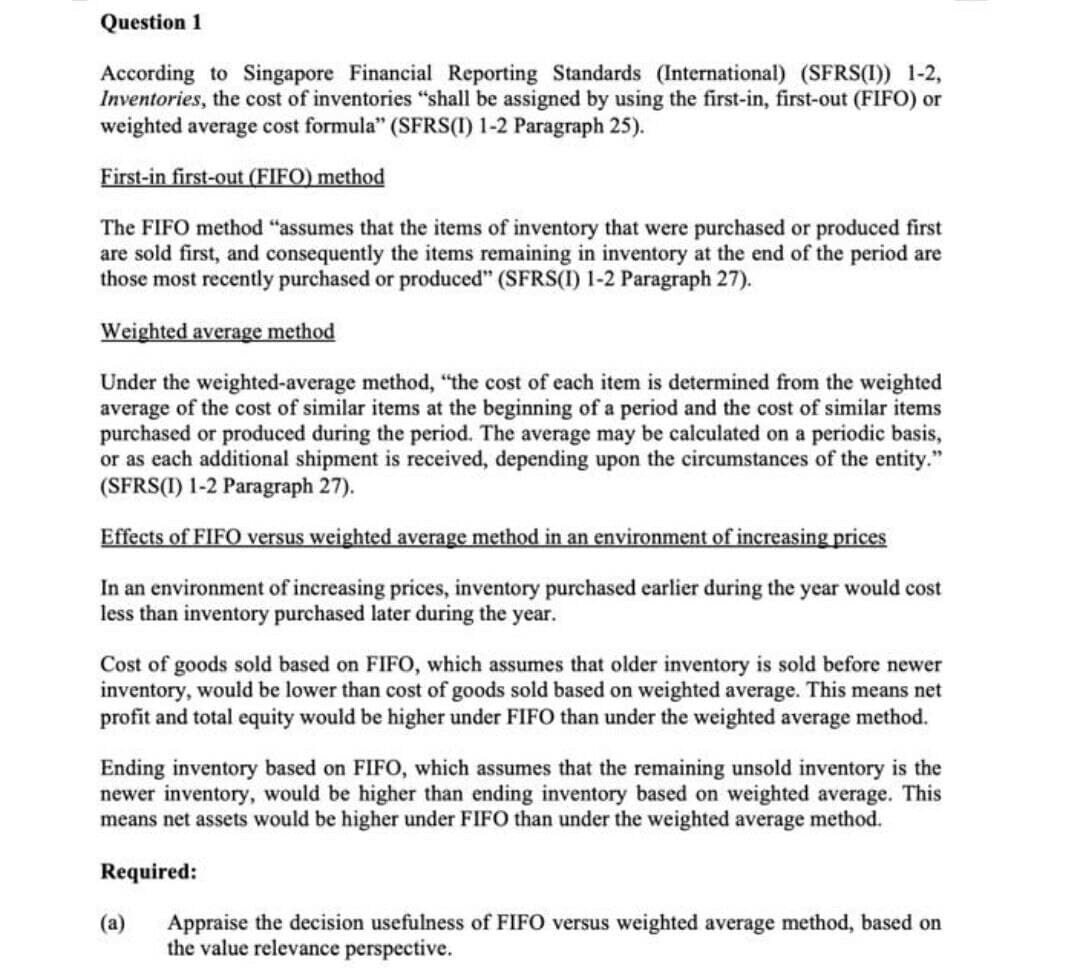Required: (a) Appraise the decision usefulness of FIFO versus weighted average method, based on the value relevance perspective.
Required: (a) Appraise the decision usefulness of FIFO versus weighted average method, based on the value relevance perspective.
Cornerstones of Financial Accounting
4th Edition
ISBN:9781337690881
Author:Jay Rich, Jeff Jones
Publisher:Jay Rich, Jeff Jones
Chapter6: Cost Of Goods Sold And Inventory
Section: Chapter Questions
Problem 41BE: ( Appendix 6B) Inventory Costing Methods: Periodic Inventory Systems. Refer to the information for...
Related questions
Question

Transcribed Image Text:Question 1
According to Singapore Financial Reporting Standards (International) (SFRS(I)) 1-2,
Inventories, the cost of inventories "shall be assigned by using the first-in, first-out (FIFO) or
weighted average cost formula" (SFRS(1) 1-2 Paragraph 25).
First-in first-out (FIFO) method
The FIFO method "assumes that the items of inventory that were purchased or produced first
are sold first, and consequently the items remaining in inventory at the end of the period are
those most recently purchased or produced" (SFRS(I) 1-2 Paragraph 27).
Weighted average method
Under the weighted-average method, "the cost of each item is determined from the weighted
average of the cost of similar items at the beginning of a period and the cost of similar items
purchased or produced during the period. The average may be calculated on a periodic basis,
or as each additional shipment is received, depending upon the circumstances of the entity."
(SFRS(1) 1-2 Paragraph 27).
Effects of FIFO versus weighted average method in an environment of increasing prices
In an environment of increasing prices, inventory purchased earlier during the year would cost
less than inventory purchased later during the year.
Cost of goods sold based on FIFO, which assumes that older inventory is sold before newer
inventory, would be lower than cost of goods sold based on weighted average. This means net
profit and total equity would be higher under FIFO than under the weighted average method.
Ending inventory based on FIFO, which assumes that the remaining unsold inventory is the
newer inventory, would be higher than ending inventory based on weighted average. This
means net assets would be higher under FIFO than under the weighted average method.
Required:
Appraise the decision usefulness of FIFO versus weighted average method, based on
the value relevance perspective.
(a)
Expert Solution
This question has been solved!
Explore an expertly crafted, step-by-step solution for a thorough understanding of key concepts.
Step by step
Solved in 2 steps

Knowledge Booster
Learn more about
Need a deep-dive on the concept behind this application? Look no further. Learn more about this topic, accounting and related others by exploring similar questions and additional content below.Recommended textbooks for you

Cornerstones of Financial Accounting
Accounting
ISBN:
9781337690881
Author:
Jay Rich, Jeff Jones
Publisher:
Cengage Learning

Financial & Managerial Accounting
Accounting
ISBN:
9781285866307
Author:
Carl Warren, James M. Reeve, Jonathan Duchac
Publisher:
Cengage Learning

Financial Accounting
Accounting
ISBN:
9781337272124
Author:
Carl Warren, James M. Reeve, Jonathan Duchac
Publisher:
Cengage Learning

Cornerstones of Financial Accounting
Accounting
ISBN:
9781337690881
Author:
Jay Rich, Jeff Jones
Publisher:
Cengage Learning

Financial & Managerial Accounting
Accounting
ISBN:
9781285866307
Author:
Carl Warren, James M. Reeve, Jonathan Duchac
Publisher:
Cengage Learning

Financial Accounting
Accounting
ISBN:
9781337272124
Author:
Carl Warren, James M. Reeve, Jonathan Duchac
Publisher:
Cengage Learning

Accounting (Text Only)
Accounting
ISBN:
9781285743615
Author:
Carl Warren, James M. Reeve, Jonathan Duchac
Publisher:
Cengage Learning

Corporate Financial Accounting
Accounting
ISBN:
9781305653535
Author:
Carl Warren, James M. Reeve, Jonathan Duchac
Publisher:
Cengage Learning